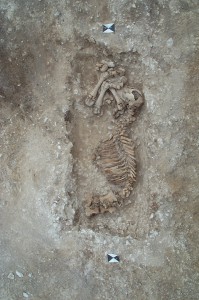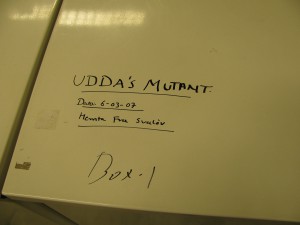- Learn urban aquaculture.
- Learn phylogenetics online.
- Learn about the CGIAR’s manifesto for agriculture and climate change from Andy’s new blog.
- Learn about the importance of hide processing in East Africa.
- Learn about the latest blow to British cooking.
- Learn about monastic gardening.
- Learn about the USDA’s microbial collections. They’re agrobiodiversity too.
- Learn what is the latest crop to get its genome sequenced.
- Learn about a private livestock genebank in the US.
- Learn about the effect of biofuel crop diversity on insect diversity.
Bringing back the aurochs
From our occasional contributor Michael Kubisch.
Anyone who has seen Jurassic Park (and who hasn’t) will understand how this film has stirred the imagination by suggesting the possibility of bringing back species that have long gone extinct. Add to that the recent breakthroughs in our ability to retrieve and decipher genomes obtained from tissues of animals that have perished thousands of years ago and you can understand the excitement. Italian scientists now claim to have a rough draft of the genome of the aurochs, a wild bovid that roamed Europe until perhaps as late as the 17th century and which is depicted so beautifully in the cave paintings in Lascaux. With the genome map as a compass the Italians are convinced that they can now breed back the aurochs using contemporary cattle breeds as a starting point.
Such attempts are, of course, not new and there are bovids around that are thought to resemble the aurochs. But in the past such efforts were always fraught with a fair degree of uncertainty because they relied entirely on phenotypic information gleaned from drawings or written descriptions. Having actual genetic information of the aurochs takes that uncertainty out of the equation. Whether the Italians’ efforts will be more successful is hard to predict because they are based on the assumption that all of the genetic information of the aurochs can still be found somewhere in modern cattle. And it is far from clear whether that is the case. But even if it isn’t, having the aurochs genome at hand, it may one day be possible to make the necessary genetic changes to transform a modern cattle embryo into an aurochs embryo and have that embryo then carried to term in a modern cow. And if you can bring back the aurochs, it may quite well be possible to bring back animal breeds that have similarly vanished. Still sounds a bit like science fiction? Perhaps, but nobody ever thought you could clone a sheep.

Nibbles: Butchered, Drought, Extension, Deforestation, AnGR, Soyabean, Sagittaria, Urban ag, Grasslands
- Locavore carnivores learn their chops.
- Researchers from Michigan to study drought in East Africa.
- Researchers from Michigan to improve African access to research.
- Get online to save the Amazon.
- “When the National Animal Germplasm Program (NAGP) opened its doors a decade ago, it started out with genetic material from 40 lines of chicken…”
- And today’s genome sequencing project is…
- Hunting wapato.
- Mexican agriculture comes to LA.
- Today’s answer to climate change is…
Do we dislike genetic engineers and plant breeders?
James, of the Giant Corn, asks an interesting question:
Do most people who work in the agricultural biodiversity field not like genetic engineering (and even plant breeders)?
This is prompted by his reading of Gary Nabhan’s Where our food comes from, which is about Vavilov and crop diversity and much else besides. James, who is studying for a PhD in plant biology at UC Berkeley, seems to think that the world — or at least Gary Nabhan — has it in for plant breeders and even more so for genetic engineers. I think it is salutary that a plant scientist, someone who has worked on teosinte and it’s more selected form, maize, had barely heard of Vavilov in all his training, and I’m really glad that he has now discovered Nabhan’s book (no matter what he thinks of it) and, more importantly, Vavilov. Here’s part of how I answered his question, in haste:
[T]he greater one’s awareness of agricultural biodiversity, the stronger is the impression that single “breeding” solutions, especially in relation to pest and disease resistance, are inevitably overtaken by the much more rapid evolutionary turnover of pests and diseases. Genetic engineering is even more simple minded than classical plant breeding, transferring just one or a few genes, and is thus even more prone to being overtaken by evolution on the part of the pest or disease. And for nutritional changes, dietary diversity delivers so many additional benefits compared to biofortified staples, that we find it odd that so much money and effort goes into the former and so little into the latter.
In his reply, James talked about stacking resistance genes and high vitA corn (maize) and conceded that both were a lot more work than genetic engineering, especially without molecular markers. My own view, for what it is worth, is that genetic engineering only seems faster. To truly have an impact, the constructs really ought to be put into a wide range of varieties that will thrive in a wide range of conditions. That takes time. So does clearing the regulatory hurdles. And in the end, at least so far, the bottom-line yield gains have hardly been worth sharpening a pencil to write home about.
I am definitely not against plant breeding, nor am I against genetic engineering per se. I do think that genetic engineering has been appallingly managed, has yet to deliver anything of interest to the people who actually have to eat its products (apart from the first ever cleared product, GE tomato paste), and has sucked vast gobs of cash and a few good minds from more interesting and more (intellectually) rewarding science. Other than that, I personally have nothing against it.
In other news: The Scientist Gardener reports that Monsanto’s patent on its first generation herbicide resistant Roundup Ready soybean is about to expire! and suggests that “[w]e’d be even better off (more competition, more disruptive technologies) if we loosened up genetic engineering regulation and let the small guys play”.
Now there’s a thought.
Barley mutants take over world
Sometimes nature needs a little help. That was brought home to me in emphatic fashion last week as I listened to the formidable Udda Lundqvist summarize her more than half a century making and studying barley mutants. Some 10,000 barley mutants are conserved at NordGen. In this freezer, in fact:

And Udda described some of the main ones during her talk. You can see some of them, and read all about this work, in her 1992 thesis.
Useful mutations in barley include a wide range of economically important characters: disease resistance, low- and high-temperature tolerance, photo- and thermo-period adaptation, earliness, grain weight and -size, protein content, improved amino acid composition, good brewing properties, and improved straw morphology and anatomy in relation to superior lodging resistance.
Some of these have found their way into commercial varieties.
Through the joint work with several Swedish barley breeders (A. Hagberg, G. Persson, K. Wiklund) and other scientists at Svalöf, a rather large number of mutant varieties of two-row barley were registered as originals and commercially released (Gustafsson, 1969; Gustafsson et al., 1971). Some of them have been of distinct importance to Swedish barley cultivation. Two of these varieties, ‘Pallas’, a strawstiff, lodging resistant and high-yielding erectoides mutant, and ‘Mari’, an extremely early, photoperiod insensitive mutant barley, were produced directly by X-irradiation.
Udda is in her 80s but shows little sign of slowing down.